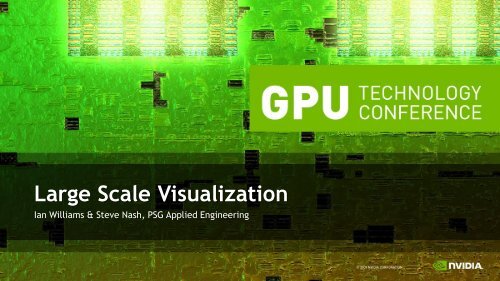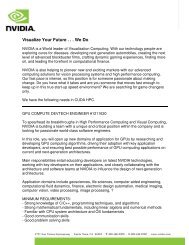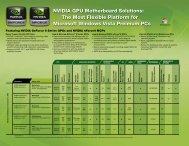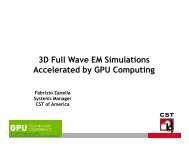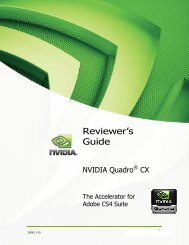Large Scale Visualization
Large Scale Visualization
Large Scale Visualization
Create successful ePaper yourself
Turn your PDF publications into a flip-book with our unique Google optimized e-Paper software.
<strong>Large</strong> <strong>Scale</strong> <strong>Visualization</strong><br />
Ian Williams & Steve Nash, PSG Applied Engineering
Agenda<br />
• Intro – Quadro Solutions<br />
• High Resolution & HDR Displays and Implications<br />
• Stereo<br />
• HDR<br />
• Implications of Multiple display channels<br />
• Addressing Multiple GPUs<br />
• SLI Mosaic mode<br />
• Combining Technologies
Quadro Visual Computing Platform<br />
SceniX<br />
Scene Graph<br />
NVIDIA<br />
SLI<br />
C CUDA<br />
OpenCL<br />
SLI<br />
Mosaic Mode<br />
NVIDIA<br />
CUDA<br />
SLI<br />
Multi OS<br />
30-bit<br />
Color<br />
NVDIA<br />
G-Sync<br />
mental<br />
ray<br />
reality<br />
server<br />
NVIDIA<br />
HD SDI<br />
PhysX<br />
CompleX<br />
Multi-GPU<br />
NVIDIA<br />
Quadro Plex<br />
VCS<br />
OptiX<br />
Interactive<br />
Ray Tracing
Quadro FX Family<br />
Product<br />
Segment<br />
Ultra High-End<br />
High-End<br />
High-End<br />
Mid-Range<br />
Entry<br />
Entry<br />
Target<br />
Audience<br />
4D Seismic Analysis<br />
4D Medical Imaging<br />
Digital Special Effects<br />
Product Styling<br />
High End MCAD<br />
Digital Effects<br />
Broadcast<br />
Midrange CAD<br />
Midrange DCC<br />
Volume CAD<br />
Volume DCC<br />
Volume CAD<br />
Volume DCC<br />
Productivity Apps<br />
Key Additional<br />
Features<br />
+ 4GB GPU Memory<br />
+ 240 CUDA Parallel Cores<br />
+ G-Sync<br />
+ SLI Frame Rendering<br />
+ SDI<br />
+ Stereo<br />
+ SLI Multi-OS<br />
+25% better Perf than FX 580<br />
+30% better performance<br />
than FX 380<br />
+ 30-bit Color<br />
+50% Better Performance<br />
than FX 370<br />
Quadro<br />
Solution<br />
Quadro<br />
FX 5800<br />
Quadro<br />
FX 4800<br />
Quadro<br />
FX 3800<br />
Quadro<br />
FX 1800<br />
Quadro<br />
FX 580<br />
Quadro<br />
FX 380<br />
Estimated<br />
Street Price<br />
$ 3,299<br />
$ 1,799<br />
$ 899<br />
$ 599<br />
$ 149<br />
$ 99
Quadro Systems<br />
Product Segment<br />
1U Rackmount<br />
Deskside<br />
or<br />
3U Rackable<br />
Target<br />
Audience<br />
Offline & Remote<br />
Rendering<br />
Seismic Analysis<br />
Product Styling<br />
Scalable Graphics<br />
Key Additional<br />
Features<br />
Four GPUs<br />
16 GB total GPU<br />
Memory<br />
2 GPUs<br />
SLI Mosaic Mode<br />
- Easy 4K<br />
CompleX<br />
OptiX<br />
Quadro<br />
Solution<br />
Tesla<br />
S1070<br />
Estimated<br />
Street Price<br />
$ 9,000<br />
QuadroPlex<br />
2200 D2 $ 10,750
AXE – Engine Relationships<br />
CgFX<br />
API<br />
QB<br />
Stereo<br />
API<br />
30-bit<br />
& SDI<br />
API<br />
AXE<br />
Center<br />
SceniX<br />
scene<br />
management<br />
engine<br />
AXE<br />
Flexibility<br />
OptiX<br />
ray tracing<br />
engine<br />
CompleX<br />
scene scaling<br />
engine<br />
AXE<br />
Reach<br />
Non-Graphic<br />
Applications<br />
Custom<br />
Applications<br />
Open<br />
SceneGraph
Application Acceleration Engines - Overview<br />
• SceniX– scene management engine<br />
– High performance OpenGL scene graph built<br />
around CgFX for maximum interactive quality<br />
– Provides ready access to new GPU capabilities & engines<br />
• CompleX – scene scaling engine<br />
– Distributed GPU rendering for keeping complex scenes interactive<br />
as they exceed frame buffer limits<br />
– Direct support for SceniX, OpenSceneGraph, and soon more<br />
• OptiX – ray tracing engine<br />
– Programmable GPU ray tracing pipeline<br />
that greatly accelerates general ray tracing tasks<br />
– Supports programmable surfaces and custom ray data<br />
Autodesk Showcase customer example<br />
15GB Visible Human model from N.I.H.<br />
OptiX shader example
Why use <strong>Large</strong> <strong>Scale</strong> <strong>Visualization</strong>?<br />
• Quality<br />
• Detail<br />
• Pixel real estate<br />
• Stereo<br />
• Immersive experience<br />
• Industry specific needs<br />
• …….
Display Technologies<br />
• Panels<br />
• Industry focused – e.g. medical, video<br />
• Projectors<br />
• Multiple Panels<br />
• Multiple Projectors<br />
Images courtesy of HP, Sony, Barco, Mechdyne,
Quadro FX Graphics<br />
Quadro G-Sync Card<br />
<strong>Large</strong> <strong>Scale</strong> <strong>Visualization</strong><br />
> 8 DVI<br />
4-8 DVI<br />
2-4 DVI<br />
1-2 DVI<br />
Beyond 8 DVI Dual Link Requires Clustered PCs<br />
with Quadro G-Sync to synchronize displays and<br />
Multi GPU aware software.<br />
Displays<br />
Applications written to run on a single<br />
display just work across larger display<br />
formats.<br />
8 Any Application Runs<br />
4<br />
1<br />
Linear Performance<br />
increase with<br />
Quadro Plex<br />
1 2 4<br />
GPUs<br />
(Does not need to be<br />
multi GPU aware)
Implications of High Resolution and<br />
HDR<br />
• Performance<br />
• Stereo<br />
• “Mechanics” of >8bit per component<br />
• Multiple display channels<br />
• OS impact<br />
• Synchronization<br />
• Clustering
Performance Implications of High<br />
resolutions & HDR<br />
• GPU memory<br />
• 3840x2160 desktop at 16x FSAA ~400MB of framebuffer.<br />
• Performance<br />
• Fill-rate<br />
• Window system implications<br />
• Texture size & depth<br />
• 16 bit per component<br />
• ……..
Stereo<br />
• Consumer Stereo Drivers (3DVision)<br />
• Stereo separation from single stream<br />
• OpenGL Quad Buffered Stereo<br />
• Application has explicit control of the stereo<br />
image<br />
• Active<br />
• Passive<br />
L, R, L, R, L, R, ……<br />
L, L, L, L, L, L, ……<br />
R, R, R, R, R, R, ……
“Mechanics” of >8bit per component<br />
• Possible using both DVI or Display Port<br />
• Display Port much easier<br />
• Textures etc. need to be >8bit per component<br />
• FP16, I16 (G8x GPUs and beyond)<br />
• RGBA, LA, L
Implementing HDR over DVI<br />
• Full screen only<br />
• Desktop, GUI, etc will not be correctly displayed<br />
• Format specific to display device<br />
• Outline:<br />
• Configure double-wide desktop<br />
• Significantly easier if exported by the EDID<br />
• Create full-screen window<br />
• Render to off-screen context<br />
• E.g. OpenGL FBO<br />
• Draw a textured quad<br />
• Use fragment program to pack pixels - display device specific<br />
• G8x GPUs (and beyond) implement bitwise fragment operations as well as fixed<br />
point textures
Implementing HDR over DVI<br />
- cont<br />
R G B<br />
Off-screen buffer<br />
R G B R G B<br />
16 bit per component<br />
8 bits 2 bits 8 bit per component<br />
Full-Screen Window<br />
Specific packing format is Display Specific
Implementing HDR over DVI<br />
- cont<br />
R G B<br />
Off-screen buffer<br />
16 bit per component<br />
8 bits 2 bits 8 bit per component<br />
R G B R G B<br />
0 2048<br />
Full-Screen Window<br />
Specific packing format is Display Specific
HDR and Display Port<br />
• Requires native Display Port GPU<br />
• Desktop will be display correctly (in 8bit)<br />
• Outline:<br />
• Open 10bit per component Pixel Format/Visual<br />
• Render
Multiple Display Channels<br />
Why multiple display channels?<br />
• Resolutions becoming larger than channel<br />
bandwidths<br />
• Sony, JVC 4K projectors<br />
• Barco and Mitsubishi panels<br />
• …….
Implications of Multiple Display<br />
Channels<br />
First a couple of questions:<br />
• Which OS - Windows or Linux?<br />
• Level of application transparency:<br />
• Driver does everything?<br />
• Application willing to do some work?
Multiple Displays - Windows<br />
• Attach Multiple Monitors using Display Properties<br />
• Extend the Desktop to each GPU<br />
• Ensure ordering is correct for desired layout<br />
• Adjust Resolutions and Refresh Rates<br />
• Displays using Refresh Rates
Multiple Displays - Windows
Multiple Displays - Windows<br />
Things you don’t intend<br />
are also possible
Multiple Displays - Windows<br />
Things to note:<br />
• Windows can be opened anywhere on (and off) the complete desktop<br />
• Windows can span display boundaries<br />
• However maximizing will lock to one display<br />
• Where the window centroid is located<br />
• Likewise full screen windows<br />
• WGL Desktop size is considered outer rectangle spanning all displays<br />
• Driver will typically send data to all GPUs (in case window is moved, etc.)<br />
• GPU Affinity OpenGL extension solves this
Multiple Displays - Windows<br />
DISPLAY_DEVICE lDispDev;<br />
DEVMODE lDevMode;<br />
lDispDev.cb = sizeof(DISPLAY_DEVICE);<br />
if (EnumDisplayDevices(NULL, 0, &lDispDev, NULL)) {<br />
}<br />
EnumDisplaySettings(lDispDev.DeviceName, ENUM_CURRENT_SETTINGS, &lDevMode);<br />
g_hWnd1 = createWindow(hInstance, lDevMode.dmPosition.x, lDevMode.dmPosition.y, X0, Y0);<br />
if (!g_hWnd1) {<br />
}<br />
MessageBox(NULL, "Unable to create first window(s).", "Error", MB_OK); return E_FAIL;<br />
if (EnumDisplayDevices(NULL, 1, &lDispDev, NULL)) {<br />
}<br />
EnumDisplaySettings(lDispDev.DeviceName, ENUM_CURRENT_SETTINGS, &lDevMode);<br />
g_hWnd2 = createWindow(hInstance, lDevMode.dmPosition.x, lDevMode.dmPosition.y, X1, y1);<br />
if (!g_hWnd2) {<br />
}<br />
Verify first display exists and get display settings<br />
Create Window on first display<br />
Verify second display exists and get display settings<br />
Create Window on second display<br />
MessageBox(NULL, "Unable to create second window(s).", "Error", MB_OK); return E_FAIL;
Addressing Multiple GPUs on<br />
Windows<br />
GPU Affinity<br />
• WGL extension (WGL_NV_gpu_affinity), core OpenGL not touched<br />
• GLX definition in the works<br />
• Application creates affinity-DC<br />
• HDC wglCreateAffinityDCNV(const HGPUNV *phGpuList);<br />
• Special DC that contain list of valid GPUs -> affinity mask<br />
• Affinity mask is immutable<br />
• Application creates affinity context from affinity-DC<br />
• As usual with RC = wglCreateContext(affinityDC);<br />
• Context inherits affinity-mask from affinity-DC<br />
• Application makes affinity context current<br />
• As usual using wglMakeCurrent()<br />
• Context will allow rendering only to GPU(s) in its affinity-mask
Addressing Multiple GPUs on<br />
Windows cont.<br />
GPU Affinity<br />
• Affinity context can be made current to:<br />
• Affinity DC<br />
• Affinity mask in DC and context have to be the same<br />
• There is no window associated with affinity-DC. Therefore:<br />
• Render to pBuffer<br />
• Render to FBO<br />
• DC obtained from window (regular DC)<br />
• Rendering only happens to the sub-rectangle(s) of the window that overlap the parts of the<br />
desktop that are displayed by the GPU(s) in the affinity mask of the context.<br />
• Sharing OpenGL objects across affinity contexts only allowed if<br />
affinity mask is the same<br />
• Otherwise wglShareLists will fail
Addressing Multiple GPUs on<br />
Windows cont.<br />
GPU Affinity<br />
• Enumerate all GPUs in a system<br />
• BOOL wglEnumGpusNV(int iGpuIndex, HGPUNV *phGpu);<br />
• Loop until function returns false<br />
• Enumerate all display devices attached to a GPU<br />
• BOOL wglEnumGpuDevicesNV(HGPUNV hGpu,<br />
int iDeviceIndex, PGPU_DEVICE lpGpuDevice);<br />
• Returns information like location in virtual screen space<br />
• Loop until function returns false<br />
• Query list of GPUs in an affinity-mask<br />
• BOOL wglEnumGpusFromAffinityDCNV(HDC hAffinityDC,<br />
int iGpuIndex, HGPUNV *hGpu);<br />
• Loop until function returns false<br />
• Delete an affinity-DC<br />
• BOOL wglDeleteDCNV(HDC hdc);
Addressing Multiple GPUs cont.<br />
GPU Affinity – Render to Off-screen FBO<br />
#define MAX_GPU 4<br />
int gpuIndex = 0;<br />
HGPUNV hGPU[MAX_GPU];<br />
HGPUNV GpuMask[MAX_GPU];<br />
HDC affDC;<br />
HGLRC affRC;<br />
while ((gpuIndex < MAX_GPU) && wglEnumGpusNV(gpuIndex, &hGPU[gpuIndex])) {<br />
}<br />
gpuIndex++;<br />
GpuMask[0] = hGPU[0];<br />
GpuMask[1] = NULL;<br />
affDC = wglCreateAffinityDCNV(GpuMask);<br />
<br />
affRC = wglCreateContext(affDC);<br />
wglMakeCurrent(affDC, affRC);<br />
<br />
glBindFramebufferEXT(GL_FRAMEBUFFER_EXT, b);<br />
<br />
Create list of the first MAX_GPUs in the system<br />
Create an affinity-DC associated with first GPU<br />
Make the FBO current to render into it
Multiple Displays - Linux<br />
• Two traditional approaches depending on desired level of<br />
application transparency or behavior:<br />
• Separate X screens<br />
• 3D Windows can’t span X screen boundaries<br />
• Location of context on GPU allows driver to send data<br />
to only that GPU<br />
• Xinerama<br />
• One large virtual desktop<br />
• 3D Windows can span X screen boundaries<br />
• Will typically result in driver sending all data to all<br />
GPUs (in case window moves)
Multiple Displays - Linux<br />
• Use nvidia-xconfig to create customized xorg.conf<br />
• nvidia-settings provides full featured control panel for Linux<br />
• Drivers can capture EDID<br />
• Useful when display device hidden behind KVM or optical cable<br />
• Synchronizing multiple displays requires G-sync card
Synchronizing Multiple Displays<br />
• Requires G-sync<br />
• Synchronize vertical retrace<br />
• Synchronize stereo field<br />
• Enables swap barrier<br />
• OpenGL Extensions<br />
• Windows: WGL_NV_Swap_Group<br />
• Linux: GLX_NV_Swap_Group
WGL_NV_Swap_Group<br />
Name<br />
NV_swap_group<br />
Dependencies<br />
WGL_EXT_swap_control affects the definition of this extension.<br />
WGL_EXT_swap_frame_lock affects the definition of this extension.<br />
Overview<br />
This extension provides the capability to synchronize the buffer swaps<br />
of a group of OpenGL windows. A swap group is created, and windows are<br />
added as members to the swap group. Buffer swaps to members of the swap<br />
group will then take place concurrently.<br />
This extension also provides the capability to sychronize the buffer<br />
swaps of different swap groups, which may reside on distributed systems<br />
on a network. For this purpose swap groups can be bound to a swap barrier.<br />
This extension extends the set of conditions that must be met before<br />
a buffer swap can take place.<br />
BOOL wglJoinSwapGroupNV(HDC hDC,<br />
GLuint group);<br />
BOOL wglBindSwapBarrierNV(GLuint group,<br />
GLuint barrier);<br />
BOOL wglQuerySwapGroupNV(HDC hDC,<br />
GLuint *group);<br />
GLuint *barrier);<br />
BOOL wglQueryMaxSwapGroupsNV(HDC hDC,<br />
GLuint *maxGroups,<br />
GLuint *maxBarriers);<br />
BOOL wglQueryFrameCountNV(HDC hDC,<br />
GLuint *count);<br />
BOOL wglResetFrameCountNV(HDC hDC);
GLX_NV_swap_group<br />
Name<br />
NV_swap_group<br />
Overview<br />
This extension provides the capability to synchronize the buffer swaps<br />
of a group of OpenGL windows. A swap group is created, and windows are<br />
added as members to the swap group. Buffer swaps to members of the swap<br />
group will then take place concurrently.<br />
This extension also provides the capability to sychronize the buffer<br />
swaps of different swap groups, which may reside on distributed systems<br />
on a network. For this purpose swap groups can be bound to a swap barrier.<br />
This extension extends the set of conditions that must be met before<br />
a buffer swap can take place.<br />
Bool glxJoinSwapGroupNV(Display *dpy,<br />
GLXDrawable drawable, GLuint group);<br />
Bool glxBindSwapBarrierNV(Display *dpy,<br />
GLuint group,<br />
GLuint barrier);<br />
Bool glxQuerySwapGroupNV(Display *dpy,<br />
GLXDrawable drawable, GLuint *group);<br />
GLuint *barrier);<br />
Bool glxQueryMaxSwapGroupsNV(Display *dpy,<br />
GLuint screen, GLuint *maxGroups,<br />
GLuint *maxBarriers);<br />
Bool glxQueryFrameCountNV(Display *dpy,<br />
GLuint *count);<br />
Bool glxResetFrameCountNV(Display *dpy);
Using G-sync<br />
Recommendations:<br />
• Control Panel will cause regular CPU contention<br />
• Polls hardware status<br />
• Use additional synchronization mechanisms in addition to<br />
swapbarrier<br />
– Broadcast frame count
SLI Mosaic Mode<br />
Multiple Displays made easy!<br />
• Enables transparent use of multiple GPUs on multiple displays<br />
• Enables a Quadro Plex (multiple GPUs) to be seen as one logical GPU<br />
by the operating system<br />
• Applications ‘just work’ across multi GPUs and multi displays<br />
• Works with OGL, DX, GDI etc<br />
• Zero or minimal performance impact for 2D and 3D<br />
applications compared with a single GPU per single display<br />
• Doesn’t support multiple View Frustums
SLI Mosaic Mode<br />
Details<br />
• Quadro Plex only<br />
• Operating System support<br />
• Windows XP, Linux, 32bit and 64bit<br />
• Vista/Win 7 soon<br />
• Maximum desktop size = 8k X 8k<br />
• FSAA may exacerbate desktop size<br />
• Compatible with G-sync<br />
• Clustering tiled displays<br />
• Supports Stereo
SLI Mosaic Mode<br />
Configurations
Performance Hit for Multiple Displays<br />
Viewperf 10.0<br />
1<br />
0.9<br />
0.8<br />
0.7<br />
0.6<br />
0.5<br />
0.4<br />
0.3<br />
0.2<br />
0.1<br />
0<br />
3dsmax-04 catia-02 ensight-03 maya-02 proe-04 sw-01 tcvis-01 ugnx-01<br />
1 screen<br />
4 screens<br />
8 screens
SLI Mosaic Performance Advantage<br />
1.2<br />
1<br />
0.8<br />
0.6<br />
0.4<br />
0.2<br />
0<br />
Viewperf 10.0<br />
3dsmax-04 catia-02 ensight-03 maya-02 proe-04 sw-01 tcvis-01 ugnx-01<br />
1 screen<br />
4 screens, Mosaic<br />
8 screens, Mosaic
Programmatically controlling Mosaic<br />
Mode<br />
• NvAPI provides direct access to NVIDIA GPUs and<br />
drivers on Windows platforms<br />
• Nvidia Control Panel GUI shows tested configurations<br />
• More advanced configuration possible through NvAPI
Programatically controlling Mosaic<br />
Mode (cont’d)<br />
NV_MOSAIC_TOPOLOGY topo; // struct defines rowcount, colcount & gpuLayout<br />
NV_MOSAIC_SUPPORTED_TOPOLOGIES supportedTopoInfo; // list of topologies<br />
// Get List of Supported Topologies and display resolutions<br />
nvStatus = NvAPI_Mosaic_GetSupportedTopoInfo(&supportedTopoInfo, type);<br />
// Set Mosaic Mode for a given topology<br />
nvStatus = NvAPI_SetCurrentMosaicTopology(&topo);<br />
// To Disable Mosaic Mode<br />
nvStatus = NvAPI_EnableCurrentMosaicTopology(0);
Beyond SLI Mosaic Mode<br />
• Can combine Mosaic for partial set of all GPUs<br />
• Use CUDA or GPU Affinity for non-display GPUs<br />
• Requires “Manual” Configuration<br />
• Combine Mosaic with CompleX Application<br />
Acceleration Engine
Summary<br />
• Demand for <strong>Large</strong> <strong>Scale</strong> Viz & HDR technologies are being<br />
driven by economics<br />
• E.g. Digital Prototypes significantly less expensive than physical<br />
prototypes however demand high quality and realism<br />
• Very large resolutions are de-facto standard for collaborative<br />
and large venue installations<br />
• Pixel bandwidth requirements still require multiple channels,<br />
even with Display Port<br />
• Some large venue displays are HDR capable
Summary – cont.<br />
• Be aware of performance implications when using multiple<br />
GPUs<br />
– Use affinity/Separate Xscreens<br />
• Solutions like SLI Mosaic Mode extends the reach of <strong>Large</strong><br />
<strong>Scale</strong> <strong>Visualization</strong><br />
• Combining solutions enables unprecedented realism and<br />
interactivity<br />
– CompleX + Mosaic = interactive massive datasets<br />
– OptiX + Mosaic = unprecedented realism on a large scale<br />
– Compute + viz cluster = flexible utilization with massive compute power
Thank You!<br />
• Feedback & Questions.


